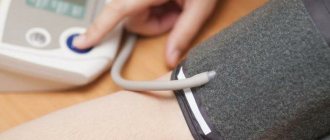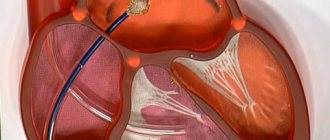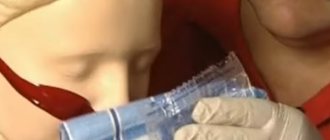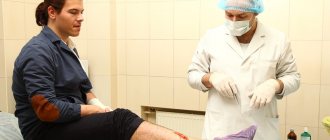The method of first aid for capillary bleeding depends entirely on the scale and depth of the damage, the general condition of the victim and some other factors. It is advisable to try to stop the bleeding, maintaining normal hemodynamics and ensuring normal functioning of the internal organs. The main actions are as follows:
- For a minor abrasion or scratch, treating with an antiseptic and applying a bactericidal patch is sufficient.
- If the damage to the limb is extensive, the arm or leg is raised up, reducing the pressure, and then treated with an antiseptic solution. It is recommended to apply a hemostatic sponge to the wound. It will stop the bleeding and eliminate bacteria. If such a sponge is not available, you will need a pressure bandage and a cooling compress on top of it.
- If nosebleeds begin, the victim is slightly tilted forward, the wings of the nose are pinched, and the bridge of the nose is cooled with a compress. For severe bleeding, cotton or gauze swabs soaked in hydrogen peroxide are inserted into the nostrils.
- If there is a suspicion of internal bleeding, it is necessary to call a team of doctors.
What is the main danger of capillary bleeding?
First aid for capillary bleeding should not be called an unnecessary procedure. Compared to arterial and venous bleeding, capillary bleeding is not so dangerous, and in most cases the body copes with it on its own. But there are situations that are life-threatening:
- the skin is extensively damaged;
- the ambient temperature is increased;
- blood clotting is impaired;
- There is blood poisoning, oncology, hepatitis, arterial hypertension and other severe pathologies.
The most dangerous is bleeding as a result of damage to the blood vessels of internal organs. Prolonged bleeding provokes a decrease in blood pressure, oxygen starvation, and disruption of the cardiovascular system. If the blood loss is severe, the person dies without treatment. Hemorrhage in the brain affects important centers and also leads to a fatal outcome. Pleural bleeding disrupts breathing and puts pressure on the lung. In most cases, it is important to react in time to manifestations of capillary bleeding and provide first aid in a timely manner.
Types of bleeding
The types of bleeding are very diverse, and for each of them the causes, signs and mechanism of development will be different.
Treatment tactics will be individual in each case. Depending on the type of damaged vessel:
- Arterial.
The cause of this bleeding is damage to arteries of various sizes. A characteristic sign is the pulsating nature of blood discharge from the wound. The blood has a bright scarlet color.
- Venous.
Occurs when veins are damaged, both large and small. Depending on the size of the vessel, the intensity of bleeding will be different, but the peculiarity is the absence of pulsation and the dark burgundy color of the blood.
- Capillary.
With this type of injury, blood flows out quite slowly and appears on the injured surface in characteristic drops.
- Parenchymal.
It occurs due to injuries to internal organs and bones. At the same time, it can be very difficult to determine where the bleeding vessel is located.
- Combined.
In this case, a combination of several types of bleeding is observed. Often occurs in cases of severe injuries, for example in an accident or at work.
In addition, obvious and hidden types of bleeding are distinguished, and they are also subdivided depending on the time of their occurrence.
Depending on the direction of blood flow:
- External.
In this case, the blood leaves the human body through natural openings or through a wound. From a diagnostic point of view, this type of bleeding is easier to identify. The sick themselves or the people around them quickly notice that such a person needs medical help. Examples of such bleeding include nasal, gastrointestinal, uterine, etc.
- Symptoms of a blood clot in the arm: the first signs of the disease, and what should every person know about them?
- Internal.
With this type, the blood goes beyond the vascular bed, but does not leave the body. It can accumulate in the lumen of hollow organs or permeate surrounding tissues.
There are many types of such bleeding, these include hematomas, intracranial hemorrhages, blood can accumulate in the pleural, abdominal, and pericardial cavities.
This pathological condition is extremely dangerous, since signs of bleeding may be insignificant or absent altogether. The patient will feel that he needs the help of a doctor when his condition is already quite serious.
How to quickly stop bleeding?
Small injuries can be easily localized by applying pressure to the wound for 5 minutes with a hand or cloth to form a blood clot. For cut wounds, the edges will stick together after some time. The skin around the wound is carefully wiped with the available antiseptic, then a bactericidal patch or sterile bandage is applied.
If a deep venous injury with drip bleeding is detected, it is necessary to sit or lay the victim down in order to elevate the damaged area above the heart. A hemostatic sponge is applied to painful large wounds, securing it with a bandage. The sponge gradually dissolves on its own; there is no need to remove it. In the absence of a sponge, apply a pressure bandage to the wound. Gauze folded in 2-3 layers and a bandage for fixation are suitable. If blood has leaked through the bandage, apply a piece of cotton wool and bandage again over the first bandage.
With internal bleeding, the victim feels drowsiness, weakness, and wants to drink. The pulse quickens, the pressure drops, the head is dizzy. Damage to the stomach is indicated by vomiting blood, intestines - tar-like stool, rectum - scarlet blood in the stool, ureters - red urine. If internal capillary bleeding is suspected, first aid will be to lie the victim down and apply cold to the damaged area. Then the doctors who arrived to the call act.
How to competently provide first aid for severe capillary bleeding?
First aid for capillary bleeding involves applying a tourniquet. The indication is extensive damage, impaired coagulation. Rules for applying a tourniquet:
- Wrap the tourniquet 2 times around the injured limb above the wound. Correct actions lead to the fact that the pulse under the wound will not be palpable.
- Place a piece of fabric under the tourniquet to avoid trophic changes.
- Be sure to record the exact time of application of the tourniquet. The skin condition is monitored.
- In the warm season, you can leave the tourniquet on the body for up to 2 hours, in winter - no more than 1 hour. Every 30 minutes you need to relax the rubber band for 30 seconds to avoid tissue death. If everything is done correctly, the limb does not turn blue or swell. And vice versa.
After applying a rubber tourniquet, the victim is quickly sent to the hospital for diagnosis and treatment. If you don’t have a rubber band at hand, use a belt, scarf, or tie.
Arterial bleeding - temporary cessation of arterial bleeding
First aid for bleeding from an artery requires special care, reactivity and speed. Make sure the victim has no fractures and elevate the injured limb. A tissue twist or tourniquet should be placed above the injury site. The time limit is the same as for stopping venous bleeding. Instead of fixing material, you can press the artery with your finger at the point of pulsation above the point of damage. If the ulnar, popliteal, femoral, or brachial arteries are bleeding, you need to fix the limb in the most bent and elevated position.
Application of a tourniquet
Effective first aid for bleeding requires 100% stopping of blood flow from the damaged blood vessel. If dressings, fabric twists and other available means are powerless in this matter, you should use a tourniquet. But remember that this is a last resort, since in most cases it leads to damage to tissue and nerve trunks. Application of a tourniquet is also indicated for traumatic amputation and difficulty determining the site of bleeding.
Main causes and symptoms
Capillaries are the smallest vessels, and in normal cases, their superficial damage to the skin does not pose any danger. Stopping the bleeding occurs on its own and does not require special action. The main sign of damaged capillaries is bright red blood. It flows slowly, there is no pulsation. The blood clotting system will work quickly. The vessel contracts, the blood flow slows down and stops due to the formation of a blood clot from platelets and fibrin fibers. Typically the process lasts up to 5 minutes.
Causes of capillary bleeding:
- abrasions, scratches and cuts;
- burns;
- low platelet concentration (thrombocytopenic purpura);
- decreased coagulability (hemophilia);
- pseudohemophilia - increased vascular permeability, causing spontaneous bleeding;
- oncology;
- purulent inflammation of the skin affecting the capillaries;
- atherosclerosis;
- hormonal imbalance, etc.
External bleeding is noticeable immediately, but internal bleeding (from the vessels of the stomach, uterus, intestines) is determined by the person’s condition. The main signs are weakness and drowsiness for no particular reason, pale skin, severe thirst, rapid pulse, decreased blood pressure. Sometimes the listed symptoms are accompanied by severe shortness of breath, nausea, fainting and dizziness. If first aid is not provided in time, internal capillary bleeding can be fatal.
Features of internal hemorrhages
For those wishing to provide first aid in road traffic accidents, it is enough to study the basic concept and types of external bleeding about blood loss, since possible hidden hemorrhages are diagnosed by specialists in medical institutions. The satisfactory state of health of victims after injury should not be a reason for avoiding further examination:
- external injury to the abdominal cavity is associated with hemorrhage from the liver, intestines, and other gastrointestinal organs;
- injuries to the lumbar region sometimes lead to kidney rupture.
Treatment of mixed bleeding in injuries is carried out in most cases by surgical methods, by opening the corresponding cavity, ligating blood vessels, and removing part of the damaged organ. Conservative measures with constant medical supervision are carried out only if there is insignificant blood loss.
The most common non-traumatic types of internal bleeding are:
- from the upper and middle sections of the digestive system - esophagus, stomach, liver;
- their lower sections - the large and small intestines.
Pathological conditions can be caused by peptic ulcers, gastritis, tumors, thrombosis of mesenteric vessels and other diseases. As part of the diagnosis, special studies are carried out. Depending on the causes of hemorrhage, the choice of conservative or surgical methods depends. Treatment includes replenishment of circulating blood, elimination of the causes of blood loss, and complex therapy of the underlying disease.
Hidden bleeding is determined by indirect manifestations. Accumulations of blood fluid in the cavities put pressure on the internal organs, interfere with their functioning, and cause complications. Many signs of internal bleeding are general:
- weakness;
- drowsiness;
- pale skin;
- low blood pressure;
- frequent heartbeat.
Specific symptoms in clinical practice appear with a more thorough examination and establishment of cause-and-effect relationships.
Signs of bleeding. Table 2.
| Problem | Symptoms |
| Hemothorax | Shortness of breath, difficulty breathing, weakening of percussion sound in the lower chest |
| Hemopericardium | Feeling of fear, sweating, pain in the heart, swelling of the veins of the neck, face, limbs |
| Bleeding into the abdominal cavity | Abdominal bloating, pain in the upper parts on palpation |
| Bleeding in the skull area | Dizziness, fainting, other neurological disorders |
The leakage of blood from the vascular bed negatively affects the entire body. Due to a decrease in total circulating blood, cellular nutrition and cardiac activity deteriorate, and anemia develops. The consequence is complications in the form of foci of necrosis in the liver, acute pulmonary failure, manifestations of anuria, parenchymal jaundice, and other pathologies.
- Signs of arterial bleeding and first aid
Obvious internal bleeding, with traces of blood leaking into the external environment, manifests itself as follows:
- gastrointestinal bleeding - modified blood gradually comes out in the process of vomiting dark blood, tarry black stools (melena) are formed;
- bleeding in the lung - expectoration of light, bright scarlet blood;
- hemorrhage from the renal pelvis, bladder - hematuria and blood in the urine are observed.
Some chronic pathologies are associated with the risk of internal bleeding. The presence of the first symptoms is a signal for an urgent visit to the attending physician.











